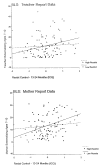Interaction of temperamental resistance to control and restrictive parenting in the development of externalizing behavior
- PMID: 9779744
- PMCID: PMC2791965
- DOI: 10.1037//0012-1649.34.5.982
Interaction of temperamental resistance to control and restrictive parenting in the development of externalizing behavior
Abstract
Child temperament and parental control were studied as interacting predictors of behavior outcomes in 2 longitudinal samples. In Sample 1, data were ratings of resistant temperament and observed restrictive control in infancy-toddlerhood and ratings of externalizing behavior at ages 7 to 10 years; in Sample 2, data were retrospective ratings of temperament in infancy-toddlerhood, observed restrictive control at age 5 years, and ratings of externalizing behavior at ages 7 to 11 years. Resistance more strongly related to externalizing in low-restriction groups than in high-restriction groups. This was true in both samples and for both teacher- and mother-rated outcomes. Several Temperament x Environment interaction effects have been reported previously, but this is one of very few replicated effects.
Figures



Similar articles
-
Infancy parenting and externalizing psychopathology from childhood through adulthood: developmental trends.Dev Psychol. 2009 Jul;45(4):909-12. doi: 10.1037/a0015675. Dev Psychol. 2009. PMID: 19586169 Free PMC article.
-
Trajectories of externalizing behavior from age 2 to age 9: relations with gender, temperament, ethnicity, parenting, and rater.Dev Psychol. 2008 May;44(3):771-86. doi: 10.1037/0012-1649.44.3.771. Dev Psychol. 2008. PMID: 18473643
-
Teacher ratings of externalizing behavior at school entry for boys and girls: similar early predictors and different correlates.J Child Psychol Psychiatry. 1998 May;39(4):555-66. J Child Psychol Psychiatry. 1998. PMID: 9599783
-
Patterns of Sensitivity to Parenting and Peer Environments: Early Temperament and Adolescent Externalizing Behavior.J Res Adolesc. 2019 Mar;29(1):225-239. doi: 10.1111/jora.12382. Epub 2018 Mar 14. J Res Adolesc. 2019. PMID: 29537722 Free PMC article. Review.
-
[Temperament, psychological development and psychopathology. Correlations, explanatory models and forms of intervention].Z Klin Psychol Psychopathol Psychother. 1993;41(1):43-68. Z Klin Psychol Psychopathol Psychother. 1993. PMID: 8511953 Review. German.
Cited by
-
A Developmental Psychopathology Perspective on ADHD and Comorbid Conditions: The Role of Emotion Regulation.Child Psychiatry Hum Dev. 2015 Dec;46(6):951-66. doi: 10.1007/s10578-015-0534-2. Child Psychiatry Hum Dev. 2015. PMID: 25662998 Review.
-
Iron deficiency in infancy and mother-child interaction at 5 years.J Dev Behav Pediatr. 2006 Oct;27(5):371-8. doi: 10.1097/00004703-200610000-00001. J Dev Behav Pediatr. 2006. PMID: 17041272 Free PMC article.
-
Translating models of antisocial behavioral development into efficacious intervention policy to prevent adolescent violence.Dev Psychobiol. 2010 Apr;52(3):277-85. doi: 10.1002/dev.20440. Dev Psychobiol. 2010. PMID: 20175096 Free PMC article.
-
Growth in temperament and parenting as predictors of adjustment during children's transition to adolescence.Dev Psychol. 2006 Sep;42(5):819-32. doi: 10.1037/0012-1649.42.5.819. Dev Psychol. 2006. PMID: 16953689 Free PMC article.
-
Predicting growth curves of externalizing behavior across the preschool years.J Abnorm Child Psychol. 2003 Dec;31(6):575-90. doi: 10.1023/a:1026254005632. J Abnorm Child Psychol. 2003. PMID: 14658739
References
-
- Achenbach TM. Manual for the Child Behavior Checklist/4–18 and 1991 Profile. Burlington: University of Vermont. Department of Psychiatry; 1991a.
-
- Achenbach TM. Manual for the Teacher’s Report Form and 1991 Profile. Burlington: University of Vermont, Department of Psychiatry; 1991b.
-
- Achenbach TM, Edelbrock C. Manual for the Child Behavior Checklist and Revised Child Behavior Profile. Burlington: University of Vermont, Department of Psychiatry; 1983.
-
- Achenbach TM, Edelbrock C. Manual for the Teacher’s Report Form and Teacher Version of the Child Behavior Profile. Burlington: University of Vermont, Department of Psychiatry; 1986.
-
- Arcus D, Gardner S. When biology is not destiny; Paper presented at the biennial meeting of the Society for Research in Child Development; New Orleans, LA. 1993. Mar,

